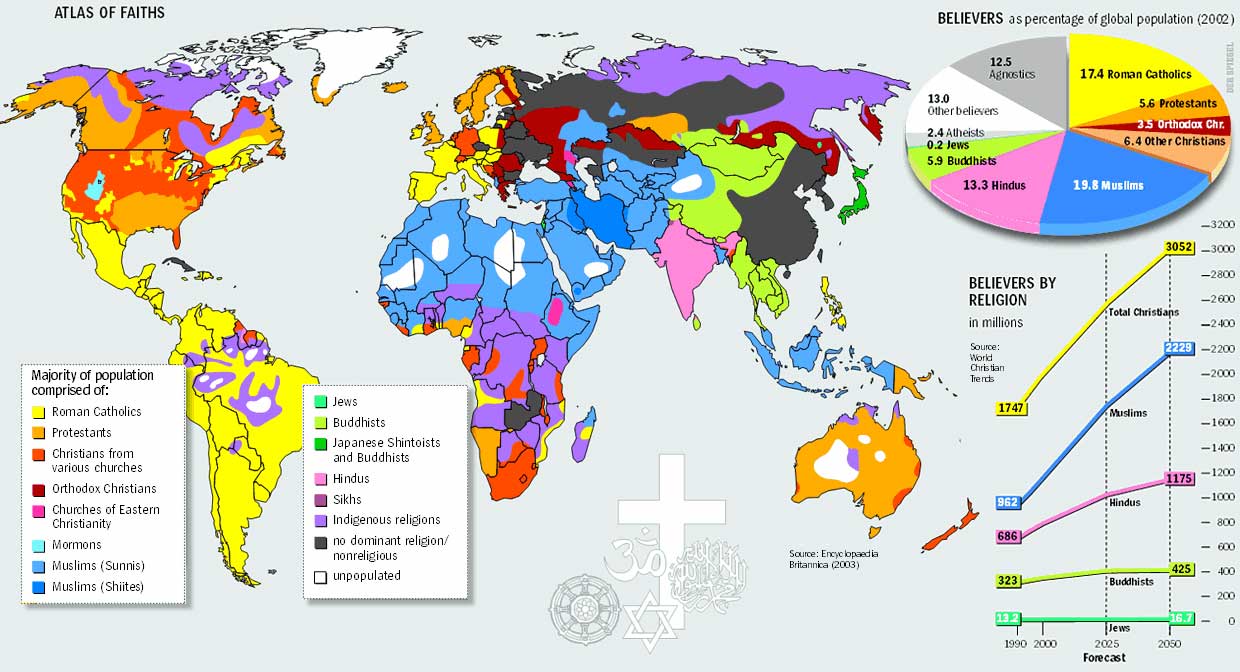 |
Unlike many of his predecessors, Hick
does not punctuate his assessment of the rigid exclusivity within the
many other faith traditions with condemnation or rebuke. Instead, he
argues that the theological error which he describes occurs naturally
as a function of the human condition. As he notes “Psychologically,
then, the sense of the unique sense of superiority of one's own
religious tradition may be simply a natural form of pride in an
engrained preference for ones own familiar group and ways.” For
this, Hick's argument has a strong element of persuasiveness. It does
not alienate, and therefore, does not provoke so much instinctive
criticism. He presents a refreshing sense of twentieth century
optimism, anticipating Star Trek and the fall of the Berlin Wall,
both of which played heavily on themes of unity, globalism, and
cooperation.
The problem, Hick says, is that
“natural pride...becomes harmful...when elevated to the level of
absolute truth.” In such cases, he argues, the results include
“persecution, coercion, and repression.” A less contentious
solution is a “reality-centered” conceptualization of faith in
which “another product will serve as an adequate second best.”
Tolerance, Hick understands, is extremely becoming of a religion of
peace. With a secular world drifting away from traditional values and
cultural patterns, the strenuous divisions of faith create a
contentious atmosphere of suspicion and resentment, especially as the
many groups vie for political influence and carve out there own
communities. This process likely does more to sustain secularization
than it does to attract new followers. In a sense, what Hick is
saying is that the religions of the world have a great deal of
incentive to set aside their minor cultural differences in favor of a
cooperative and mutually inclusive relationship.
By and large, research indicates that
the majority of the faithful in America are more likely to identify
more closely with Hick's message of religious equality, but the
fringe radical groups are several orders of magnitude more vocal, and
therefore, more likely to be heard. However, each group has
demonstrated a need to accommodate some particular shift in social
evolution in order to survive. In light of the gay riots in New York
and gay boycotts in San Francisco, hatemongers like Jerry Falwell and
Anita Bryant compromise the benevolent nature of Christian theology
to reign in the socially mal-adapted audiences that will consistently
vote on religious cues. On the other hand, however warm and inviting
Hick's utopian hypothesis might appear, it is also a deliberate and
necessary attempt to dial back the eighteen hundred years of failed
social principles against which Marx had once taken his humanist
stand. He leaves open the question of how to resolve natural conflict
between secular and religious authorities. He avoids the Christian
and Muslim mandates to convert, evangelize, and proselytize. He
dodges the then-half-century-old Arab-Israeli crisis, the conflict
between Sharia law and the Cataclysm, and escapes without
consideration the many atheists in the middle.
Effectively, because one may assume
that John Hick is not widely read in the non-Christian, non-academic
world, Hicks message of concilliarism mostly implies a fragile
reconciliation between the Lutheran and the Baptist who happen to
find themselves co-inhabiting a set of bus seats on occasion. Odds
are it will find little meaning or value in a world struggling to
decide how to deal with organizations like ISIS and the KKK.
Hick also quietly dodges a more
plausible explanation for the emerging trend toward religious
pluralism in spite of dogmatic supremacy. In recent years,
researchers have demonstrated pretty convincingly that atheists are
often more well versed in Christian doctrine than Christians
themselves. There is a fascinating engine driving this phenomenon.
Christianity itself is a complex matrix of debates, discoveries,
decisions, and demands which grew out of centuries of exploration,
tradition, inspiration, and reflection. The learning curve for new
Christians might as well be a perfect vertical line compared to that
of the early church fathers. Each particular denomination is
different from the next, and after a generation or two of dogmatic
drift, neglected exploration, and artistic license, no religion can
confidently hold its adherence to any very unique set of
expectations. In short, what people actually know about their
religion is in decline, as access to other, more interesting subject
matter competes for a progressively greater share of public
attention. Conversely, what there is to
know about religion in general increases exponentially as more and
more theologians examine and discover and publish. It makes sense
then, that at some point, these religions would tend to blend
together in a grand theocratic wash. Though Hick's approach is novel,
in a way, he is just following
the logical path of least resistance. The world is secularizing
because of science, not sin, and not because of anyone's concept of
religious supremacy.
There are few
easier subjects for contemplation than a world in which everyone gets
along. Or that the subject one has devoted one's life to isn't slowly
disintegrating beneath one's feet. Image Source: http://www.china-mike.com/wp-content/uploads/2011/03/map-world-religions-chart.jpg